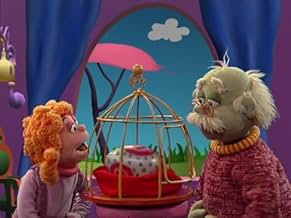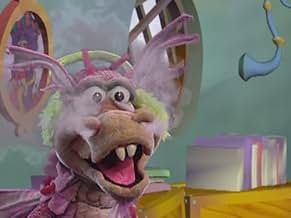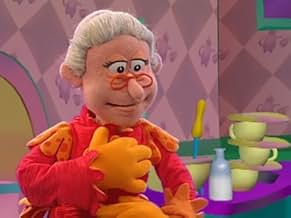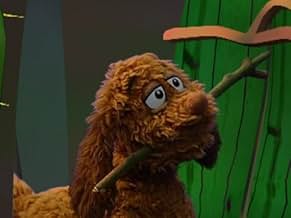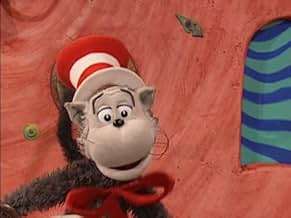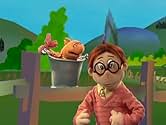AVALIAÇÃO DA IMDb
6,9/10
213
SUA AVALIAÇÃO
Adicionar um enredo no seu idiomaAn extravagant universe containing a variety of notable characters featured in classic stories by Dr. Seuss in the form of puppetry.An extravagant universe containing a variety of notable characters featured in classic stories by Dr. Seuss in the form of puppetry.An extravagant universe containing a variety of notable characters featured in classic stories by Dr. Seuss in the form of puppetry.
- Indicado para 2 Primetime Emmys
- 1 vitória e 8 indicações no total
Explorar episódios
Enredo
Você sabia?
- CuriosidadesAll of the backgrounds are computer-generated.
- ConexõesFeatured in The Blockbuster Buster: The Cat in the Hat (2012)
Avaliação em destaque
This is a show not a lot of people know about except if they grew up in the '90s. Nothing's been said of it since it was quietly cancelled in 1998.
Nickelodeon wasn't kind to it. They premiered the show around the same time as Arnold and Blue's Clues, but it barely received any recognition unlike those two shows, and some focus groups complained about how scary it was. In October 1997, for its second and final season that would premiere in March of the following year, it moved to Nick Jr.
I remember first watching The Wubbulous World of Dr. Seuss, a Jim Henson production based on the works of Theodor Geisel, on VHS. Sony Pictures (then known as Columbia Tristar) Home Entertainment released a majority of the second season on VHS in 1999 and eventually a majority of the first season on DVD in the 2000s (along with other preschooler-friendly fare like Jay Jay the Jet Plane, The Berenstain Bears and Maggie and the Ferocious Beast). By the time I did, the show had long been off the air. I used to like watching the VHS volumes of the show that were released in 1999, but now I don't.
Each episode of The Wubbulous World of Dr. Seuss' first season was a self-contained story revolving around various Dr. Seuss characters (i.e. Horton the Elephant, Morton the Elephant-Bird, the Grinch, Jane and Junior Kangaroo, Thidwick the Big-Hearted Moose, Mr. Knox, and Fox in Socks). The Cat in the Hat was the host of the show, being quite a lot like his book counterpart. His rhymes and ways of introducing these stories were very funny and clever. He even occasionally reprised his role as a trickster like in the episodes "The Simplifier" and "Yertle the King." In the latter episode, he actually met Yertle and tried to convince him that the only thing that would make him happy was if he didn't have anything. Then the Cat and everyone else around Yertle sang a song about it, which caused him to cry.
"The grass ain't always greener... on the other side of the fence!"
Unfortunately, the Cat in the Hat took more of the host/narrator role in the second season. He had been the face of Dr. Seuss for ages since said author published the book of the same name in 1957.
In Season 2, the Cat in the Hat is little more than a Bear-like host. You know, Bear from Bear in the Big Blue House? His character is completely butchered. His screen time has also increased so much that many characters (both new to the show and from pre-existing Dr. Seuss books) who were given time to shine in Season 1 are barely existent. Hell, Yertle the Turtle and the Grinch, especially. They barely make any appearances whatsoever, and when they do they aren't as evil as they once were. Oh, and they changed the Cat's voice, too.
Twice an episode, the Cat in the Hat will get a story alert.
(fanfare plays) The Cat in the Hat: Hold that thought, bird. Right now, we've got a story to watch!
Some sort of hand comes out of nowhere and gives him a summary of the story. He reads it, then he goes to the Wubbuloscope.
The Cat in the Hat: Oh, look! It's a story! "There's a boy in Seussville who is just waking up to the most special day of his year. Felix is his name, and today he turns eight. In Seussville, a birthday is more than just great!" Let's crank up the Wubbuloscope and take a look at the map.
The purpose of the Wubbuloscope, a story-producing piece of machinery, is for the Cat in the Hat to see what's going on the Wubbulous World, but it really exists as an excuse for him to push Horton the Elephant, Morton the Elephant-Bird, Yertle, the Grinch, Jane and Junior Kangaroo, etc., and even new characters like Sarah Hall Small to the curb and nothing more. Most of these characters don't even deserve that treatment.
More often than not, the story is based around Seussville, home of Sarah Hall Small. Other times, the story is based around the Jungle of Nool or the Kingdom of Didd, but I hate Sarah and Seussville for how overused they are. Sarah Hall Small is a character created specifically for the show, and she replaced Sue Snue from the show's first season. Look, Sue didn't do anything to deserve to just disappear from the show altogether. Sarah is the worst show-exclusive character ever next to Terrence McBird.
There are lots of characters that Dr. Seuss created, and lots that they chose and could've chosen from. This show's second season seems to prefer Sarah Hall Small, the Cat in the Hat, the Little Cats, and Terrence McBird over all the other characters.
Speaking of Terrence, he's an annoying Snarf-like bird who needs to shut the hell up. The Cat in the Hat is friends with him, but Terrence is too annoying and unlikable to be considered a good friend for the Cat. However, he and Terrence do care for each other at times.
Little Cat Z is no better. He's arguably the worst of the Little Cats. He does nothing but mutter Z-words and needs to shut the hell up just like Terrence.
The Cat in the Hat: Now, what should we try?
Little Cat Z: Zip-zap, zip-zap?
The Cat in the Hat: No, we've already tried that.
SHUT THE HELL UP, CAT Z!
The Wubbulous World of Dr. Seuss could have remained mostly the same throughout its run, but it didn't. It began as an engaging and adventurous storybook-like anthology show that kept replicated the magic of the Dr. Seuss books. Then it killed off that format and shifted to only aiming at preschoolers/younger audiences instead of families/everyone/older audiences like most Dr. Seuss books. Our childhoods that Dr. Seuss, along with other children's authors like Stan and Jan Berenstain, helped make have been destroyed.
Nevertheless, it was somehow nominated for a Primetime Emmy Award for "Outstanding" Children's Program. Only THE SHOW'S FIRST SEASON can be considered outstanding. Yes, some of the worst, stupidest trash has been nominated or even WON an Emmy Award of some kind.
Nickelodeon wasn't kind to it. They premiered the show around the same time as Arnold and Blue's Clues, but it barely received any recognition unlike those two shows, and some focus groups complained about how scary it was. In October 1997, for its second and final season that would premiere in March of the following year, it moved to Nick Jr.
I remember first watching The Wubbulous World of Dr. Seuss, a Jim Henson production based on the works of Theodor Geisel, on VHS. Sony Pictures (then known as Columbia Tristar) Home Entertainment released a majority of the second season on VHS in 1999 and eventually a majority of the first season on DVD in the 2000s (along with other preschooler-friendly fare like Jay Jay the Jet Plane, The Berenstain Bears and Maggie and the Ferocious Beast). By the time I did, the show had long been off the air. I used to like watching the VHS volumes of the show that were released in 1999, but now I don't.
Each episode of The Wubbulous World of Dr. Seuss' first season was a self-contained story revolving around various Dr. Seuss characters (i.e. Horton the Elephant, Morton the Elephant-Bird, the Grinch, Jane and Junior Kangaroo, Thidwick the Big-Hearted Moose, Mr. Knox, and Fox in Socks). The Cat in the Hat was the host of the show, being quite a lot like his book counterpart. His rhymes and ways of introducing these stories were very funny and clever. He even occasionally reprised his role as a trickster like in the episodes "The Simplifier" and "Yertle the King." In the latter episode, he actually met Yertle and tried to convince him that the only thing that would make him happy was if he didn't have anything. Then the Cat and everyone else around Yertle sang a song about it, which caused him to cry.
"The grass ain't always greener... on the other side of the fence!"
Unfortunately, the Cat in the Hat took more of the host/narrator role in the second season. He had been the face of Dr. Seuss for ages since said author published the book of the same name in 1957.
In Season 2, the Cat in the Hat is little more than a Bear-like host. You know, Bear from Bear in the Big Blue House? His character is completely butchered. His screen time has also increased so much that many characters (both new to the show and from pre-existing Dr. Seuss books) who were given time to shine in Season 1 are barely existent. Hell, Yertle the Turtle and the Grinch, especially. They barely make any appearances whatsoever, and when they do they aren't as evil as they once were. Oh, and they changed the Cat's voice, too.
Twice an episode, the Cat in the Hat will get a story alert.
(fanfare plays) The Cat in the Hat: Hold that thought, bird. Right now, we've got a story to watch!
Some sort of hand comes out of nowhere and gives him a summary of the story. He reads it, then he goes to the Wubbuloscope.
The Cat in the Hat: Oh, look! It's a story! "There's a boy in Seussville who is just waking up to the most special day of his year. Felix is his name, and today he turns eight. In Seussville, a birthday is more than just great!" Let's crank up the Wubbuloscope and take a look at the map.
The purpose of the Wubbuloscope, a story-producing piece of machinery, is for the Cat in the Hat to see what's going on the Wubbulous World, but it really exists as an excuse for him to push Horton the Elephant, Morton the Elephant-Bird, Yertle, the Grinch, Jane and Junior Kangaroo, etc., and even new characters like Sarah Hall Small to the curb and nothing more. Most of these characters don't even deserve that treatment.
More often than not, the story is based around Seussville, home of Sarah Hall Small. Other times, the story is based around the Jungle of Nool or the Kingdom of Didd, but I hate Sarah and Seussville for how overused they are. Sarah Hall Small is a character created specifically for the show, and she replaced Sue Snue from the show's first season. Look, Sue didn't do anything to deserve to just disappear from the show altogether. Sarah is the worst show-exclusive character ever next to Terrence McBird.
There are lots of characters that Dr. Seuss created, and lots that they chose and could've chosen from. This show's second season seems to prefer Sarah Hall Small, the Cat in the Hat, the Little Cats, and Terrence McBird over all the other characters.
Speaking of Terrence, he's an annoying Snarf-like bird who needs to shut the hell up. The Cat in the Hat is friends with him, but Terrence is too annoying and unlikable to be considered a good friend for the Cat. However, he and Terrence do care for each other at times.
Little Cat Z is no better. He's arguably the worst of the Little Cats. He does nothing but mutter Z-words and needs to shut the hell up just like Terrence.
The Cat in the Hat: Now, what should we try?
Little Cat Z: Zip-zap, zip-zap?
The Cat in the Hat: No, we've already tried that.
SHUT THE HELL UP, CAT Z!
The Wubbulous World of Dr. Seuss could have remained mostly the same throughout its run, but it didn't. It began as an engaging and adventurous storybook-like anthology show that kept replicated the magic of the Dr. Seuss books. Then it killed off that format and shifted to only aiming at preschoolers/younger audiences instead of families/everyone/older audiences like most Dr. Seuss books. Our childhoods that Dr. Seuss, along with other children's authors like Stan and Jan Berenstain, helped make have been destroyed.
Nevertheless, it was somehow nominated for a Primetime Emmy Award for "Outstanding" Children's Program. Only THE SHOW'S FIRST SEASON can be considered outstanding. Yes, some of the worst, stupidest trash has been nominated or even WON an Emmy Award of some kind.
- samlan-61174
- 27 de abr. de 2021
- Link permanente
Principais escolhas
Faça login para avaliar e ver a lista de recomendações personalizadas
- How many seasons does The Wubbulous World of Dr. Seuss have?Fornecido pela Alexa
Detalhes
- Data de lançamento
- País de origem
- Idioma
- Também conhecido como
- A mesebanda: Dr. Seuss kacagtató kacatjai
- Locações de filme
- Empresas de produção
- Consulte mais créditos da empresa na IMDbPro
- Tempo de duração25 minutos
- Cor
Contribua para esta página
Sugerir uma alteração ou adicionar conteúdo ausente

Principal brecha
By what name was The Wubbulous World of Dr. Seuss (1996) officially released in Canada in English?
Responda





